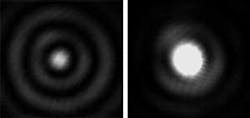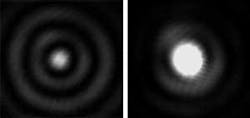Combination pupil filter enables efficient superresolution
The point-spread function (PSF) of an optical system can be altered by inserting a spatially varying filter at the pupil plane; if the filter is properly designed, the width of the central peak of the PSF can be narrowed. In real terms, this means that the focused spot of a laser beam, for example, can be made smaller without increasing the numerical aperture of the system.
So why doesn’t every focusing lens include a filter like this? The answer is that, although the spot can be made smaller, the shrinkage comes at the expense of intensity. A pupil filter-which can have spatial variations in amplitude, phase, or both-invariably shifts much of the energy from the central spot to the outlying diffraction rings (for a phase version) or absorbs almost all the light (for an amplitude version). But the resulting “superresolved” spot, though lower in intensity, can be useful for measurement purposes such as scanning microscopy or for boosting the displacement sensitivity of the spot on a quadrant detector. Pupil filters can also be used to sharpen astronomical images of stars.
Two things are desirable in a superresolving pupil filter. One is a relatively high Strehl ratio and the other is a high ratio of the peak intensity to the intensity of the first side lobe, also known as gamma (Γ). Conventional amplitude filters can have a Γ of 7 when producing small spots (less than 0.7 the size of the original), but suffer a Strehl ratio of 1 × 10-3 or less; phase filters can achieve a Strehl ratio of 0.2 but may have a Γ of only about 2. Now, researchers at EMPA (Dubendorf, Switzerland) and the Ecole Polytechnique Fédérale de Lausanne (Lausanne, Switzerland) have developed a complex (both phase and amplitude) pupil filter that achieves a good Strehl ratio and a high Γ at the same time.1
The researchers first modeled conventional amplitude filters with continuously varying transmission profiles and phase filters with radial zones, determining their properties. They then modeled a combination filter consisting of a three-zone phase filter and a continuous amplitude filter, which could produce a spot 64% the diameter of the original while maintaining a Γ of 4 and shifting less of the energy into the side lobes than would an all-phase filter.
SLM setup
To realize the filter experimentally, the researchers used two spatial light modulators (SLMs), one for phase (up to π rad) and one for amplitude (intensity variation of up to 96%). Proper orientation of polarizers ensured phase- and amplitude-only operation for the two different SLMs, each of which had an 832 × 624-pixel resolution. An optical system containing two separate pupil planes allowed easy placement of the SLMs. Laser light at 532 nm was sent through the system; a CCD camera with an 11-μm pixel spacing captured the spot.
Without the filters, the spot was measured to be 1540 μm in size. With the filters, the spot shrank to 990 μm in size (64% of the original; see figure). The Strehl ratio was about 0.1, according to Phanindra Gundu, one of the researchers. In addition, the Γ was about 4-a combination of characteristics that will boost the efficiency of superresolution via pupil filtering.
REFERENCE
1. P. N. Gundu et al., Optics Express13(8) (April 18, 2005).

